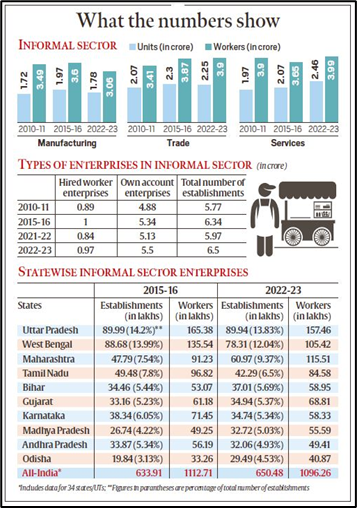Why in News?
According to the Annual Survey of Unincorporated Enterprises (ASUSE), the informal sector in India faces many challenges. Over the last seven years, many small and medium enterprises have shut and about 16.45 lakh jobs have been lost.
What’s in Today’s Article?
- Meaning of the Informal Sector of the Economy
- About the ASUSE
- Highlights of the ASUSE
- What is the Significance of the ASUSE Data?
Meaning of the Informal Sector of the Economy:
- The term unorganised/ informal sector is used interchangeably in the India context.
- It consists of small and medium enterprises and household proprietary and partnership establishments.
- The unorganised sector contributes over 44% to the country’s gross value added (GVA) and employs nearly 75% of the workforce employed in non-agricultural enterprises.
- This means the sector accounts for almost half of India’s economic output and more than three-fourths of employment.
- The share of the unorganised sector is highest in agriculture as the holdings are small and fragmented. This is followed by trade, construction, real estate, professional services, etc.
About the ASUSE:
- The ASUSE was released for the 2021-22 and 2022-23 by the Union Ministry of Statistics and Programme Implementation (MoSPI).
- It carried out surveys for unincorporated non-agricultural establishments in three sectors: manufacturing, trade, and other services.
- Unincorporated enterprises are enterprises in the unorganised/ informal sector, comprising MSMEs, household units including those with hired workers, and own-account enterprises.
- Manufacturing units other than those covered under the Factories Act 1948 and the organised manufacturing sector covered by the Annual Survey of Industries (ASI), have been surveyed.
- Under trade and other services, proprietary and partnership establishments (excluding LLPs), co-operatives, self-help groups, non-profit institutions, etc., are included.
Highlights of the ASUSE:

- The number of workers employed in the informal sector in 2022-23 has dropped by 16.45 lakh or about 1.5 per cent to 10.96 crore compared to 11.13 crore in 2015-16.
- The number of unincorporated enterprises increased by 16.56 lakh from to 6.50 crore in 2022-23 from 6.33 crore in 2015-16.
- The real GVA of unincorporated sector enterprises grew by 6.9% in 2022-23, which was still lower than the pre-pandemic level.
What is the Significance of the ASUSE Data?
- A crucial employment indicator: This is because the informal sector is closely watched for its employment generation capacity and absorption of the labour force (especially semi-skilled and unskilled labour).
- Highlights the impact of 3 shocks on the informal sector:
- The data available for the first time since 2015-16, provides an understanding of the impact of the 3 major exogenous shocks on the growth of unincorporated enterprises and the employment in these enterprises.
- These shocks are demonetisation in November 2016, rollout of the Goods and Service Tax in July 2017, and the Covid-19 pandemic in March 2020.
- Much of the brunt of these 3 shocks is borne by the informal sector.
- Presents state-specific data:
- Maharashtra, Bihar, Gujarat, MP and Odisha recorded an increase in the informal employment between 2015-16 and 2022-23.
- UP, West Bengal, Tamil Nadu, Karnataka and Andhra Pradesh registered a decline in the number of informal sector workers during the same period.
- These ten states account for nearly three quarters of the informal sector workers employed in India.
- Depicts a broad decline in employment quality: Most new jobs in the sector were created in own-account enterprises rather than hired-worker units.
- Matches with the Periodic Labour Force Survey (PLFS): As per PLFS 2022-23, there was an increase in workers in agriculture, and a decrease in manufacturing.









